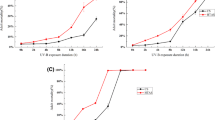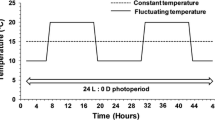Abstract
Solar ultraviolet-B (UVB) radiation has deleterious effects on plant-dwelling mites. We assessed the biological effects of UVB radiation on the eggs of the twospotted spider mite, Tetranychus urticae Koch, under both near ambient (UV+) and UV-attenuated (UV−) conditions from spring to autumn and compared them to the effects of temperature and humidity. The ambient daily UVB irradiance increased from January to August and then decreased rapidly until December, whereas egg hatchability under UV+ was lowest in April (10.7%) and increased almost linearly until October (74.9–92.3%). In contrast, hatchability under UV− was consistently high (96.2–99.8%) through all seasons. For UV+, the stepwise multiple linear regression analysis supported the negative correlation of hatchability with cumulative UVB irradiance during egg periods (cumulative dose), but did not support that with the mean daily UVB irradiance (dose rate), suggesting that UVB-induced mortality in T. urticae eggs is cumulative dose dependent rather than dose rate dependent. The high mortality in April may have reflected the slower development caused by the relatively lower temperature and higher UVB radiation, increasing the cumulative dose, while the low mortality in October may have reflected the faster development caused by the relatively higher temperature and lower UVB radiation, decreasing the cumulative dose.



Similar content being viewed by others
References
Ballaré CL, Caldwell MM, Flint SD, Robinson SA, Bornman JF (2011) Effects of solar ultraviolet radiation on terrestrial ecosystems. Patterns, mechanisms, and interactions with climate change. Photochem Photobiol Sci 10:226–241
Barcelo JA (1981) Photoeffects of visible and ultraviolet radiation on the two-spotted spider mite, Tetranychus urticae. Photochem Photobiol 33:703–706
Boudreaux HB (1958) The effect of relative humidity on egg-laying, hatching, and survival in various spider mites. J Insect Physiol 2:65–72
Bounfour M, Tanigoshi LK (2001) Effect of temperature on development and demographic parameters of Tetranychus urticae and Eotetranychus carpini borealis (Acari: Tetranychidae). Ann Entomol Soc Am 94:400–404
Bullock AK, Jeffrey WH (2010) Temperature and solar radiation interactions on 3H-leucine incorporation by bacterioplankton in a subtropical estuary. Photochem Photobiol 86:593–599
Connelly SJ, Moeller RE, Sanchez G, Mitchell DL (2009) Temperature effects on survival and DNA repair in four freshwater cladoceran Daphnia species exposed to UV radiation. Photochem Photobiol 85:144–152
Dearden PK, Donly C, Grbić M (2002) Expression of pair-rule gene homologues in a chelicerate: early patterning of the two-spotted spider mite Tetranychus urticae. Development 129:5461–5472
Ferro DN, Chapman RB (1979) Effects of different constant humidities and temperatures on twospotted spider mite egg hatch. Environ Entomol 8:701–705
Foott WH (1963) Competition between two species of mites. II. Factors influencing intensity. Can Entomol 95:45–57
Grbić M, Khila A, Lee K, Bjelica A, Grbic V, Whistlecraft J, Verdon L, Navajas M, Nagy L (2007) Mity model: Tetranychus urticae, a candidate for chelicerate model organism. BioEssays 29:489–496
Jones VP, Parrella MP (1984) Intratree regression sampling plans for the citrus red mite (Acari: Tetranychidae) on lemons in southern California. J Econ Entomol 77:810–813
Kouwenberg JHM, Browman HI, Cullen JJ, Davis RF, St-Pierre JF, Runge JA (1999a) Biological weighting of ultraviolet (280–400 nm) induced mortality in marine zooplankton and fish. I. Atlantic cod (Gadus morhua) eggs. Mar Biol 134:269–284
Kouwenberg JHM, Browman HI, Runge JA, Cullen JJ, Davis RF, St-Pierre JF (1999b) Biological weighting of ultraviolet (280–400 nm) induced mortality in marine zooplankton and fish. II. Calanus finmarchicus (Copepoda) eggs. Mar Biol 134:285–293
Lacuna DG, Uye S (2001) Influence of mid-ultraviolet (UVB) radiation on the physiology of the marine planktonic copepod Acartia omorii and the potential role of photoreactivation. J Plankton Res 23:143–155
Li J, Margolies DC (1991) Factors affecting location of Banks grass mite, Oligonychus pratensis (Acari: Tetranychidae), on corn leaves. Exp Appl Acarol 12:27–34
Matallana-Surget S, Douki T, Meador JA, Cavicchioli R, Joux F (2010) Influence of growth temperature and starvation state on survival and DNA damage induction in the marine bacterium Sphingopyxis alaskensis exposed to UV radiation. J Photochem Photobiol B Biol 100:51–56
McCloud ES, Berenbaum MR (1999) Effects of enhanced UV-B radiation on a weedy forb (Plantago lanceolata) and its interactions with a generalist and specialist herbivore. Entomol Exp Appl 93:233–247
Ohtsuka K, Osakabe Mh (2009) Deleterious effects of UV-B radiation on herbivorous spider mites: they can avoid it by remaining on lower leaf surfaces. Environ Entomol 38:920–929
Onzo A, Sabelis MW, Hanna R (2010) Effects of ultraviolet radiation on predatory mites and the role of refuges in plant structures. Environ Entomol 39:695–701
Osakabe Mh, Hongo K, Funayama K, Osumi S (2006) Amensalism via webs causes unidirectional shifts of dominance in spider mite communities. Oecologia 150:496–505
Perring TM, Holtzer TO, Toole JL, Norman JM, Myers GL (1984) Influences of temperature and humidity on pre-adult development of the banks grass mite (Acari: Tetranychidae). Environ Entomol 13:338–343
Rousseaux MC, Julkunen-Tiitto R, Searles PS, Scopel AL, Aphalo PJ, Ballaré CL (2004) Solar UV-B radiation affects leaf quality and insect herbivory in the southern beech tree Nothofagus antarctica. Oecologia 138:505–512
Sakai Y, Osakabe Mh (2010) Spectrum-specific damage and solar ultraviolet radiation avoidance in the two-spotted spider mite. Photochem Photobiol 86:925–932
Santos CD (2005) Photoreactivation of ultraviolet-B damage in Tyrophagus putrescentiae (Acari: Acaridae) and Tetranychus urticae (Acari: Tetranychidae). Int J Acarol 31:429–431
Shih CT, Poe SL, Cromroy HL (1976) Biology, life table, and intrinsic rate of increase of Tetranychus urticae. Ann Entomol Soc Am 69:362–364
Sudo M, Osakabe Mh (2011) Do plant mites commonly prefer the underside of leaves? Exp Appl Acarol 55:25–38
Suzuki T, Watanabe M, Takeda M (2009) UV tolerance in the two-spotted spider mite, Tetranychus urticae. J Insect Physiol 55:649–654
Veerman A (1974) Carotenoid metabolism in Tetranychus urticae Koch (Acari: Tetranychidae). Comp Biochem Physiol B 47:101–116
Wübben DL (2000) UV-induced mortality of zoea I larvae of brown shrimp Crangon crangon (Linnaeus, 1758). J Plankton Res 22:2095–2104
Acknowledgments
This study was supported by a Grant-in-Aid for Scientific Research from the Ministry of Education, Culture, Sports, Science, and Technology of Japan (18580053).
Author information
Authors and Affiliations
Corresponding author
Rights and permissions
About this article
Cite this article
Sakai, Y., Sudo, M. & Osakabe, M. Seasonal changes in the deleterious effects of solar ultraviolet-B radiation on eggs of the twospotted spider mite, Tetranychus urticae (Acari: Tetranychidae). Appl Entomol Zool 47, 67–73 (2012). https://doi.org/10.1007/s13355-011-0090-6
Received:
Accepted:
Published:
Issue Date:
DOI: https://doi.org/10.1007/s13355-011-0090-6




